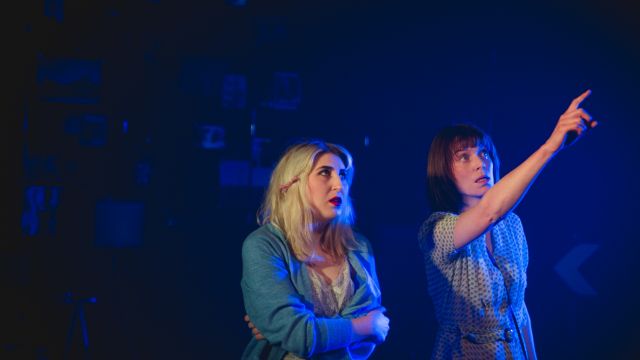Love/Chamberlain
That’s rock star Courtney Love and our Lindy Chamberlain. Bridget Mackey’s play posits a connection. Once you can accept – or get past – that premise, what we could get is an intriguing depiction of enduring loss and uncertain identity. Courtney, would-be actress as well as a musician, about to break through with the release of her first album with her band Hole in 1994, is devastated by the suicide of husband Kurt Cobain – and accused of murder – and has her child taken away because she’s an unfit mother. Lindy Chamberlain loses her baby in 1980, but most of Australia refuses to believe her story, especially when she fails to perform ‘grieving mother’ in the conventional way, and she goes to gaol as a murderer. Her conviction – and that of her husband as an ‘accessory after the fact’ – is quashed in 1988 and a movie gets made – Evil Angels (Fred Schepisi 1988), starring Meryl Streep.
With these perhaps tenuous connections, playwright Bridget Mackey constructs her play with the intention, surely, that these two lives will illuminate each other – and indeed that happens, although perhaps not as much as it might.
 Ms Mackey employs a non-linear and impressionistic structure, but the story more or less begins in, say, 1995, with the central conceit or contrivance a sort of road movie in which Courtney (Rebekah Hill) and Lindy (Dana Miltins) travel together in Central Australia. There are numerous flashbacks, such as Courtney first learning of Kurt’s suicide, and Lindy in gaol, being told by a bullying warder (Joseph Lai) that her son has been injured but that she won’t be allowed out to see him. Along the way, Mr Lai also plays all the other necessary roles – police, the British hitchhiker who fell off Uluru and whose corpse led to the discovery of Azaria’s matinee jacket, a defence lawyer and so on.
Ms Mackey employs a non-linear and impressionistic structure, but the story more or less begins in, say, 1995, with the central conceit or contrivance a sort of road movie in which Courtney (Rebekah Hill) and Lindy (Dana Miltins) travel together in Central Australia. There are numerous flashbacks, such as Courtney first learning of Kurt’s suicide, and Lindy in gaol, being told by a bullying warder (Joseph Lai) that her son has been injured but that she won’t be allowed out to see him. Along the way, Mr Lai also plays all the other necessary roles – police, the British hitchhiker who fell off Uluru and whose corpse led to the discovery of Azaria’s matinee jacket, a defence lawyer and so on.
Courtney is fascinated by Lindy and is insistent she would have played Lindy in the movie better than Streep. A striking moment has Courtney ‘rehearsing’ the murder of baby Azaria with a pair of scissors. Lindy, however, still a straightlaced Jehovah’s Witness, appears abstracted, still in the enveloping grip of the past. A recurring scene has her being timed opening a can of beans, an element in the story that the court and the public didn’t believe. She has fond if naïve memories of hanging out with her ‘friend’ Meryl Streep.
In a program note, Ms Mackey imagines that the audience will come to her play with their own ideas of these two women. Ms Miltins’ portrayal of Lindy doesn’t fit with my idea of Lindy, who has always seemed to be woman of great strength. Ms Miltins and director Cathy Hunt prefer to emphasise a rather muddled, ‘ordinary’ woman, still caught up in the crushing injustice that could have destroyed her. The triumph of the evening, however, is Ms Hill’s Courtney. Her Courtney is funny, manipulative but touching, sensual and sexy, and curiously glowing. A sort of in-joke is Nathan Burmeister’s costume design, which puts Courtney in the Frances Farmer wedding dress. Ms Hill gives us Courtney’s little-girl-lost naiveté contrasting with instinctual, calculating smarts, her vulnerability and her driving ambition and - it’s sheer invention of course - her protective kindness towards Lindy. This performance is the jewel in this dark story.
 Mr Lai, meanwhile, is very tall and very good looking with a lot of hair; he’s so distinctive that asking him to play multiple roles is a bit of a stretch – and his switches are just one more source of confusion – such as ‘where are we now? when is this? And ‘what does this mean?’
Mr Lai, meanwhile, is very tall and very good looking with a lot of hair; he’s so distinctive that asking him to play multiple roles is a bit of a stretch – and his switches are just one more source of confusion – such as ‘where are we now? when is this? And ‘what does this mean?’
An element of Eloise Kent’s set design is a kind of glowing hanging mobile made up of many photographs and as if lit by fire. It is attractive and intriguing – and it might suggest that the past is not past - but the photographs are much too small for the audience to see who is in them. Why go this trouble if the audience is excluded?
It’s one instance of a major flaw in this play and this production of it: the playmakers seem not to have considered the audience – that is, they haven’t taken audience experience into account. They seem not to’ve asked, ‘Are we clear?’ Or, ‘Can the audience hear every word in this space?’ Or, ‘Do all these little scenes with awkward transitions ruin narrative flow?’ The play has been in development since 2017 so we might expect more coherence than we get, despite the genuine originality of the central idea and the many piercing insights into these two now iconic women.
Michael Brindley
Photographer: Theresa Harrison
Subscribe to our E-Newsletter, buy our latest print edition or find a Performing Arts book at Book Nook.

